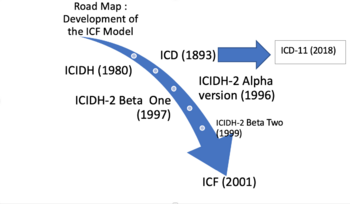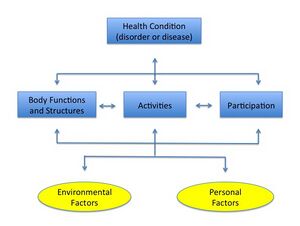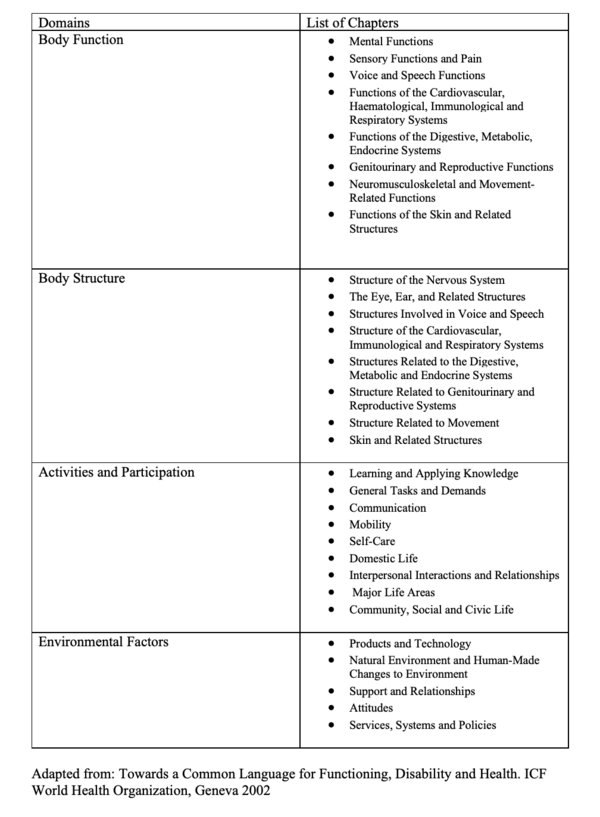Introduction to the International Classification of Functioning, Disability and Health (ICF): Difference between revisions
No edit summary |
No edit summary |
||
| Line 99: | Line 99: | ||
Table 1 shows the key components of the ICF and its chapters: | Table 1 shows the key components of the ICF and its chapters: | ||
[[File:ICF list of chapters.png|center|thumb| | [[File:ICF list of chapters.png|center|thumb|817x817px|Table 1. The key components of the ICF Model and its chapters|alt=]] | ||
== Resources == | == Resources == | ||
Revision as of 23:34, 19 June 2022
Original Editor - Ewa Jaraczewska based on the course by Patricia Saleeby
Top Contributors - Ewa Jaraczewska, Jess Bell, Kim Jackson, Tarina van der Stockt and Robin Tacchetti
Introduction[edit | edit source]
The model of disability which has been systematically developed by The World Health Organization (WHO) is based on the ongoing interaction between one's health and contextual factors. This model acknowledges that disability is a universal human experience, is etiologically neutral, and it lies on a continuum from no disability to complete disability.[1]The contextual factors affecting a person's health include real-life environment, social interactions, and social participation.[1]Every healthcare personnel needs to understand and appreciate that patient perceives his health through the lenses of his daily life impacted by the environment.[1]This course provides an introduction to the International Classification of Functioning, Disability, and Health (ICF) and review the changes and progress in conceptualising and measuring disability.
International Classification of Impairment, Disability and Handicaps (ICIDH)[edit | edit source]
International Classification of Impairment, Disability and Handicaps known as ICIDH, was published by the World Health Organization in 1980. It was a manual containing the classification related to the consequences of the disease, injuries, and other disorders and a framework for health-related information.[2]
According to the ICIDH manual, "an impairment is any loss or abnormality of a psychological, physiological, or anatomical structure or function". [3]Classification of impairments (I code) reflected:
- abnormalities of body structure (temporary or permanent)
- appearance or disturbances at the level of the organ or system function resulting from any cause
The following categories of impairments were listed in the manual: intellectual, other psychological, language, aural, ocular, visceral, skeletal, disfiguring, general, sensory and other.[3]
A disability was considered "any restriction or lack (resulting from an impairment) of ability to perform an activity in the manner or within the range considered normal for a human being".[3]Classification of disabilities (D code) reflected:
- individual's functional performance
- activity by the individual
Nine categories of disability included: behaviour, communication, personal care, locomotor, body disposition, dexterity, a situational, particular skill, and other activity restrictions.
Handicaps (H code) were defined as "the disadvantages experienced by the individual as a result of impairments and disabilities that limits or prevents the fulfilment of a role that is normal (depending on age, sex, and social and cultural factors) for that individual".[3]There were two dimensions of handicap listed in the manual: survival role, with six key dimensions, and other. Six major survival roles included: orientation, physical independence, mobility, occupation, social integration, and economic self-sufficiency.
Coding example based on ICIDH: "Unable to see" could potentially be coded as 9D90.Z (ICD-11), 51 (Impairment code), or 26 (Disability code) as each classification has different purposes, and it was up to the user to decide which classifications were appropriate.[4] ICD would be chosen to understand the cause of blindness. Classification of impairment would allow the facilitation of the grouping of low vision impairments. Disability would help to plan a course of rehabilitation because it allows specifying the outcome or prognosis of a vision-related disability.[4]
ICIDH-2[edit | edit source]
ICIDH-2 was a new version of ICIDH which was released as the alpha version in 1996, followed by beta one and beta two versions tested by WHO in 1997 and in 1999. The biggest changes in ICIDH-2 as compared to the original ICIDH included adding two new dimensions: participation in social activities and a listing of environmental factors which are important for understanding the complexity of disability.[4] This model allowed to describe the consequences of the diagnosed condition. [4]
WHO-FIC[edit | edit source]
ICD-11 and ICF constitute the core classifications of the WHO family of international classifications, otherwise known as WHO-FIC.[2]
International Classification of Disease (ICD-11)[edit | edit source]
The International Classification of Diseases (ICD) was first published in 1893. It belongs to the WHO family of classifications and is used to classify existing conditions (morbidity) and/or causes of death (mortality). The ICD is currently in its 11th revision and functions under the name of ICD-11 for Mortality and Morbidity Statistics (ICD-11-MMS).[4] [5]ICD-11 framework consists of three parts: Foundation (database), classifications (attained from Foundation), and biomedical ontology (linked to Foundation), which represents the most relevant knowledge about the disease, that should be incorporated into the coding system. COVID-19 example explains the biomedical ontology portion of the ICD-11 when various manifestations of this disease were discovered after the release of ICD-11, and they were able to be incorporated as new dimensions of the ICD-11 model. [5]
International Classification of Functioning, Disability, and Health (ICF)[edit | edit source]
In 2001, the fifty-fourth World Assembly officially approved the International Classification of Functioning, Disability and Health (ICF) as a replacement for the International Classification of Impairments, Disabilities and Handicaps (ICIDH).[6]The ICF is a classification of health and health-related domains.[2]It focuses on human functioning, from healthy to a disability, in relation to a person’s activities and participation, influenced by environmental factors, health conditions, and personal factors.[6]
The unique features of the ICF :
- includes social and environmental aspects of disability and health[2]
- allows for the identification of factors at both individual and system levels[2]
- provides a framework for mental and physical disorders[2]
- allows for organisation and communication of information on human functioning[2]
- facilitates interdisciplinary and inter-professional practice, by providing specificity and a common language in the world of functioning and disability[7]
- allows for an interactive relationship between health conditions, impairments, functional limitation/activity restrictions and environmental and personal factors.[8]In this model, the relationship is not linear, but one component influencing and being influenced by other factors [8]
- data collection allows the user to determine the associations and the causal links between components[2]
ICF and Rehabilitation[edit | edit source]
The role of the ICF in rehabilitation is evolving. The following are present and potential implications of the ICF for rehabilitation:
- concept of functioning and disability finds support in the assessment and documentation
- improvement in understanding by the rehabilitation professionals all the domains of participation and how the environment influences the participation, and to include them when planning rehabilitation and anticipating the outcomes
- strengthening universality and standardisation of functions, disabilities, and health[6]
- focusing on removing environmental barriers when rehabilitation services are planned[7]
- the evolvement of the researchers’ and professionals’ reasoning when working with statistics and information related to functioning, disabilities, and health [6]
- introduction of a holistic approach to the management of patients[8]
Limitations of the ICF classification in rehabilitation:
- limited applications by the healthcare professionals, especially that outside of the rehabilitation team[8]
- limited training of an interprofessional team to adopt ICF in daily practice[8]
- limited use of the ICF in the rehabilitation setting by vocational rehabilitation counsellors [6][9]
Key Components of the ICF Model[edit | edit source]
The key components of the ICF model include health conditions, or disorders/diseases, body function and structure, activities, and participation, environmental factors, and personal factors. [2]Due to cultural variability, personal factors are not actually included in the ICF classification.They are however recognised as being essential for understanding functioning and disability.[2]
The following definitions of the ICF components are provided in the manual:[10]
Body Function and Structures:
- Body Functions: "the physiological functions of body systems (including psychological functions)"[10]
- Body Structures: "anatomical parts of the body such as organs, limbs and their components"[10]
Impairments: "problems in body function or structure". Includes a significant deviation or loss.[10]
Activity: "execution of a task or action by an individual"[10]
Participation: "involvement in a life situation"[10]
Activity Limitations: "difficulties an individual may have in executing activities"[10]
Participation Restrictions: "problems an individual may experience in involvement in life situations." [10]This may result from either impairments, activities or the environment.[2]
Environmental Factors: "physical, social and attitudinal environment in which people live and conduct their lives"[10]Environmental factors can be considered a barrier or facilitation in terms of how it affects one's functioning.[2]
'Personal factors are not classified within the ICF, but they are recognised as a key to understanding functioning and disability. The following are examples of personal factors: age, gender, race, fitness, lifestyle, habits, upbringing, coping style, social background, education, character style, and important life events.[11]
ICF Categories of the Components[edit | edit source]
The first level of each of the core components consists of chapters. Each chapter's role is to provide an overview of the area of functioning. [11]Next, chapters are classified into three levels which further describe the area of functioning.[11]
Table 1 shows the key components of the ICF and its chapters:
Resources[edit | edit source]
- International classification of impairments, disabilities, and handicaps: a manual of classification relating to the consequences of the disease, published in accordance with resolution WHA29.35 of the Twenty-ninth World Health Assembly, May 1976
- Towards a Common Language for Functioning, Disability and Health. ICF
References[edit | edit source]
- ↑ 1.0 1.1 1.2 Cieza A, Sabariego C, Bickenbach J, Chatterji S. Rethinking disability. BMC medicine. 2018 Dec;16(1):1-5.
- ↑ 2.00 2.01 2.02 2.03 2.04 2.05 2.06 2.07 2.08 2.09 2.10 2.11 Saleeby P. Introduction to Introduction to the International Classification of Functioning, Disability, and Health (ICF) Course. Physioplus 2022.
- ↑ 3.0 3.1 3.2 3.3 World Health Organization. International classification of impairments, disabilities, and handicaps: a manual of classification relating to the consequences of the disease, published in accordance with resolution WHA29. 35 of the Twenty-ninth World Health Assembly, May 1976. World Health Organization; 1980.
- ↑ 4.0 4.1 4.2 4.3 4.4 Gray DB, Hendershot GE. The ICIDH-2: developments for a new era of outcomes research. Arch Phys Med Rehabil. 2000 Dec;81(12 Suppl 2): S10-4.
- ↑ 5.0 5.1 Harrison JE, Weber S, Jakob R, Chute CG. ICD-11: an international classification of diseases for the twenty-first century. BMC Med Inform Decis Mak. 2021 Nov 9;21(Suppl 6):206.
- ↑ 6.0 6.1 6.2 6.3 6.4 Millet P. The ICF twenty years later.Available from https://web.archive.org/web/20210716185739id_/https://www.idoriums.com/edpanel/media/D05_Edorium%20Journal%20of%20Disability%20and%20Rehabilitation/2021/pdf/100050D05PM2021.pdf [last accessed 19.06.2022].
- ↑ 7.0 7.1 Madden RH, Bundy A. The ICF has made a difference in functioning and disability measurement and statistics. Disability and rehabilitation. 2019 Jun 5;41(12):1450-62.
- ↑ 8.0 8.1 8.2 8.3 8.4 Sagahutu JB, Kagwiza J, Cilliers F, Jelsma J. The impact of a training programme incorporating the conceptual framework of the International Classification of Functioning (ICF) on behaviour regarding interprofessional practice in Rwandan health professionals: A cluster randomized control trial. PloS one. 2020 Feb 7;15(2):e0226247.
- ↑ Southwick JD, Grizzell ST. Utilizing the ICF to enable evidence-based practice among vocational rehabilitation counselors. Rehabilitation Counseling Bulletin. 2020 Oct;64(1):17-30.
- ↑ 10.0 10.1 10.2 10.3 10.4 10.5 10.6 10.7 10.8 Towards a Common Language for Functioning, Disability and Health. ICF. Available from https://cdn.who.int/media/docs/default-source/classification/icf/icfbeginnersguide.pdf?sfvrsn=eead63d3_4&download=true [last accessed 19.06.2022].
- ↑ 11.0 11.1 11.2 Viljoen M, Mahdi S, Griessel D, Bolte S, de Vries PJ. Parent/caregiver perspectives of functioning in autism spectrum disorders: A comparative study in Sweden and South Africa. Autism 2019; 23(1).









